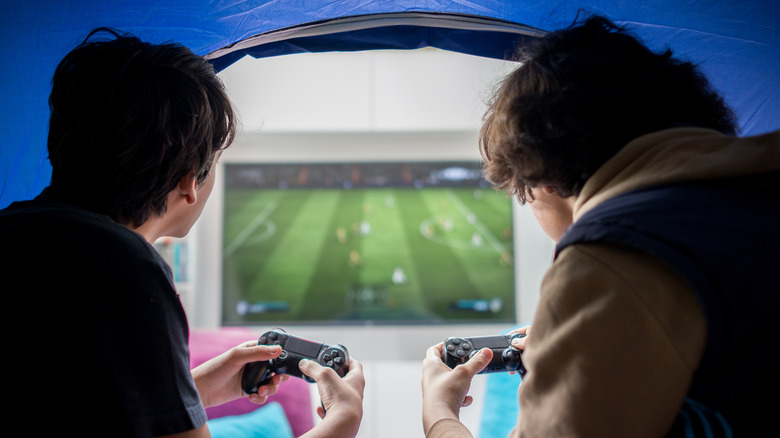How To Optimize Your Gaming Experience While Camping
While some naysayers may disagree, there are lots of perfectly acceptable ways to have fun while camping. For some people, that means doing the stuff they'd normally do at home, but hanging out in the great outdoors instead. That can mean reading a book, talking with friends, or, yes, unwinding with some video games. Since electricity and an internet connection don't exactly grow on trees, you might think gaming while camping is highly impractical, but it's not impossible.
You only need three things: Proper hardware, a power source, and optionally, an internet connection. Thankfully, there are multiple choices for each, and depending on just what sort of gaming you intend to do, the experience can vary between comfortable and passable.
Running "Starfield" with max settings on a desktop PC with a GeForce RTX 4090 will be very difficult to power off the grid. Competitive gaming of any kind might be tricky if you're planning to log on from the middle of nowhere. Playing a Game Boy is doable, but you'll need a lot of AA batteries. Like many things in life, gaming during a camping trip will require compromise, balance, and managed expectations.
Get the right hardware
Your video gaming experience in the boondocks will rely heavily on the hardware you run and the games you want to play. Fancier games require fancier hardware, which means less portability, higher energy usage, and a higher likelihood of potentially needing a stable internet connection. Even some retro consoles required a lot of power to output top-of-the-line graphics in their heyday, so check the power needs of your chosen device before setting out.
Your best bet is to stick with portable systems, which are built to sip power instead and usually have a built-in display — meaning less to carry. The Nintendo Switch, for example, uses only 6-9W an hour compared to an Xbox Series X, which tops out at nearly 150W.
You may not be able to play "Starfield" on a Steam Deck, which uses up to 20-25W per hour, but there are plenty of other games that work fine. A tablet and controller can make a decent gaming system in a pinch as well. Gaming laptops tend to use a lot of power, though, so keep that in mind before you bring your laptop along.
If you want a huge library that requires very little power, you might consider a Raspberry Pi retro gaming setup, which only uses up to 6.4W per hour when fully cranked, and can be loaded with all sorts of vintage games that definitely didn't have online requirements. You'll need to bring your own display and have a constant power source, but there are tons of energy-efficient options in both categories for the Pi.
Powering up and getting connected
If you've selected your hardware, now you need power. Between external batteries, portable generators, and even fold-up solar panels, you've got several options for making sure your gaming setup keeps running. If you're not planning to run many electronics, a good battery will do fine, but if you plan to power several devices at once, a portable generator with a solar panel to top it up throughout the day might be your best bet.
If you're looking for online play, you do have a couple of options, but they might not be great for any kind of competitive multiplayer. Some campgrounds have Wi-Fi, but the quality and stability will depend on the place where you're staying.
With the advent of 5G home internet services, you can also bring what is essentially a fancy mobile hotspot with you anywhere you go, but depending on the remoteness of your campsite, this may or may not be an option. Your connection also might not have the low latency required for hardcore online gaming.
Finally, there's the internet connection that can be used almost anywhere — satellite. Right now, the only mainstream satellite provider is Starlink, and it does have fair reviews from gamers who have tried it. However, it still likely doesn't have the latency to pull off high-end online gaming just yet.


